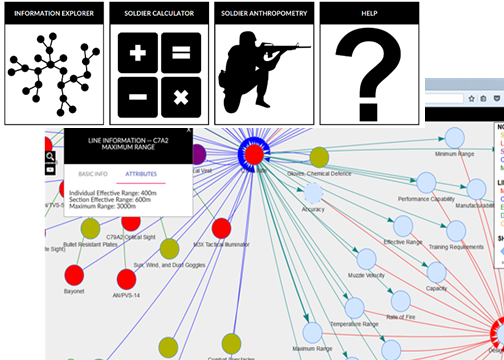Researching, developing, and understanding soldier systems (i.e., clothing, equipment, weapons, and tasks) is very challenging. For example, the successful integration of new components requires an intimate knowledge of many variables and complex relationships between data sets. HSI®, with funding from Defence Research and Development Canada (DRDC), investigated this issue and applied data visualization techniques to build a tool to improve stakeholder understanding and effectiveness when considering the soldier system.
In support of the Soldier System Effectiveness (SoSE) project, HSI® created an architecture framework for the Canadian Armed Forces (CAF) dismounted infantry soldier. After over a year of development, which included CAF intra-department and intra-program collaboration and international defence partnerships, HSI® produced an operational software demonstrator of the SoSE architecture framework focusing on the functionality and toolsets of the C7A2 weapon systems.
The SoSE Architecture hosts a variety of tools that enable soldier system stakeholders to be more effective, timely, and comprehensive in researching, designing, acquiring, training, and integrating items into the soldier system. Some of the tools include:
- Item Association Tool: Once an item of clothing or equipment or task is selected, the tool will generate a network of links to all other types of information related to that item. For example, selecting a C7 Rifle will link to training, soldier performance data, components, compatibility and interface issues, and related soldier tasks.
- Soldier System Calculator: When selecting a Military Occupational Specialty code, soldier size, climate, and load order, the tool will generate a listing of standard clothing and equipment worn or carried by that soldier. Items can be added or removed from the list using a selection tool. The calculator will compute the resulting soldier system weight, bulk, power use, cost, etc., and relate these to known standards.
- Research Planning Tool: Selecting an item of clothing or equipment or a task, the tool will provide a listing of key data and factors to consider, as well as a bibliography of related research papers. Research paper references would be an integrated, searchable database within the tool.
The Soldier System Effectiveness Architecture Framework will enable stakeholders within the CAF community to have a clear and common understanding of the many human, equipment, and task factors affecting soldier effectiveness, component design and integration, and the specific and broader implications of changing any component in the soldier system.
Jeff Bennett





